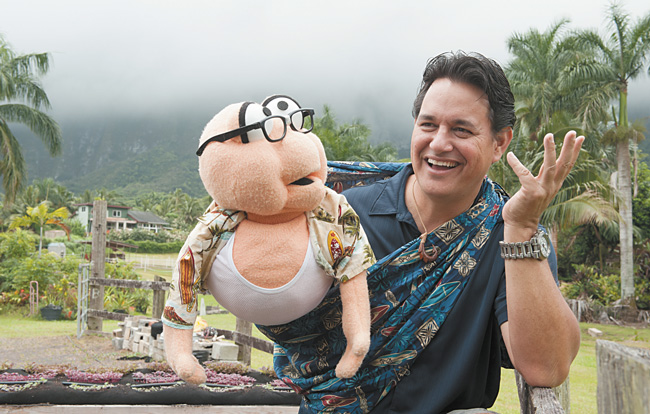On Waltah’s Farm
A bespectacled invertebrate that lives in the earth is the star of an educational kids TV show as well as the symbol of a farm-based curriculum to teach sustainability.
Nestled somewhere in a Waimanalo valley is an innovation hub quickly coming to life at Palaka Moon Farm.
Here, sustainability is more than a mere buzzword — it’s a lifestyle. On five acres of land, Sustain Hawaii has transformed this one-time sugarcane field into a hands-on, high-tech, “walk story” learning center.
Oh, and it also happens to be where OC-16 star Waltah the Worm lives.
Since Palaka Moon Farm opened in January and began offering tours in February, it has welcomed more than 500 visitors. Many have, of course, been children on field trips there to visit Waltah.
But Waltah is more than a friendly puppet that appears in an educational children’s TV series on sustainability. Really, what Waltah represents is a thoughtfully creative, integrative and new way of understanding what has become a very broad term.
“It’s time,” says Waltah the Worm producer and Sustain Hawaii board chairwoman Dr. Malia J. Smith.
“I think Hawaii is ripe and ready for something like this.”
052715_nm_1.jpg
Waltah the Worm
To understand why a worm was so culturally relevant to what Smith and Sustain Hawaii hope to accomplish with Waltah is to know a bit of Hawaiian mythology.
It is said, explains Smith, that Wakea and Ho‘ohokukalani had a stillborn child they buried in the earth. From this grew the first kalo plant, named Haloa. Wakea and Ho‘ohokukalani had another child, and this was the first man.
“Everything starts with the Earth,” says Smith. “We felt that the worm was indicative and representative of that.”
In thinking of who would join the show as its main actor, Smith immediately thought of Tony Silva, her classmate from Kamehameha Schools.
“He’s funny as hell, but his heart is amazing,” says Smith.
TV pitches and projects are nothing new to Silva, one-half of Da Bruddahs. But there was clarity in Smith’s vision — presented to Silva in a 150-page book — that impressed him.
“We’re just now at maybe 10 percent of that book,” he says. “So this is truly like the tip of the iceberg, as far as where this whole project is going.”
In the TV series, Silva plays Kimo and also provides the voice of Waltah. Together, they embark on adventures — all the while engaging viewers in systems thinking. Different from critical thinking or problem solving, systems thinking is a way of finding a connection between two discordant ideas.
“What we’re trying to show kids is that your behaviors, your actions, have an impact, no matter how small,” explains Smith. (Smith, who has a doctorate in education, writes and produces every episode of Waltah the Worm, along with help from 15-year-old daughter Gabrielle.)
Episodes feature a “logic project” to illustrate this concept. Along with this and other segments, episodes also include three main components: a nonprofit organization, an expert and a business. By doing this, Smith hopes to recognize those who are engaged in sustainability so that the show may act as a platform for the community.
But it doesn’t end with the TV show. To accompany each episode, Smith writes curriculum and lesson plans that are available to teachers online free of charge. Then there are games and other activities to provide an enriching learning experience.
“Everyone thinks it’s a TV show,” says Smith. “It’s not.
“The TV show is actually one element of five for the whole educational program.”
A big component, and what ties everything together, is a visit to Palaka Moon Farm.







